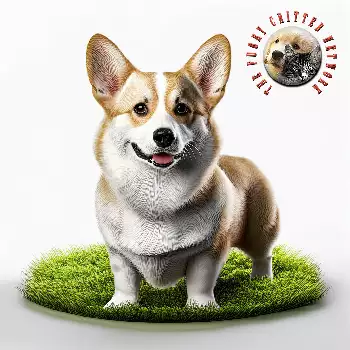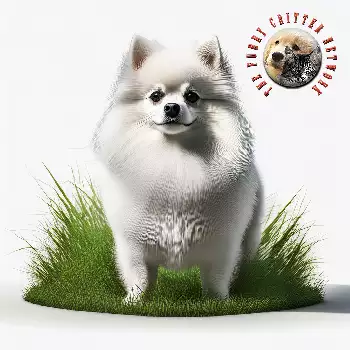Corgiranian
Hybrid Breed Description
The Corgiranian is a cross between the Corgi and the Pomeranian. Because each hybrid inherits a unique combination of traits from both parents, we recommend thoroughly researching both breeds before choosing a Corgiranian. Pay special attention to temperament, health issues, and care requirements, as your dog may express characteristics from either parent breed.
Corgi

The Pembroke Welsh Corgi stands ten to twelve inches tall at the withers and typically weighs between twenty-two and thirty pounds, though males tend toward the heavier end of this range. Despite their small stature, these dogs possess a sturdy, muscular build with a long body proportionate to their short legs, creating a distinctive low-set silhouette. Their bodies are compact yet powerful, with a level topline, deep chest, and strong hindquarters that belie their considerable agility and athletic capability. The breed features a thick double coat consisting of a soft, dense undercoat and a longer, coarse outer coat that lies relatively flat against the body. This weatherproof coat forms a distinctive ruff around the neck, chest, and shoulders, with longer feathering on the back of the forelegs and underparts. Common coat colors include red, sable, fawn, and black and tan, often with white markings on the legs, chest, neck, muzzle, and belly. Some dogs may also display a narrow blaze on their heads. The Corgi's head is described as fox-like in appearance, with a slightly rounded skull, well-defined stop, and a moderately tapered muzzle. Their dark, oval-shaped eyes convey an intelligent and alert expression, while their medium-sized, erect ears are firm and mobile, contributing to their characteristic attentive demeanor. The breed's short legs and elongated body create the appearance of a much larger dog compressed into a smaller package, a trait that historically allowed them to nip at the heels of cattle while avoiding kicks.
Key Characteristics
Pembroke Welsh Corgis are known for their quick intelligence, forceful will, and remarkably bold personalities that far exceed their diminutive size. These dogs are active, animated, and eager participants in all family activities, viewing themselves as full-sized canines in compact bodies. Their herding heritage manifests in their energetic nature and natural instinct to control movement, making them quick, determined, and surprisingly agile workers despite their short stature. Highly intelligent and trainable, Corgis are people-oriented dogs that love to work alongside their humans and excel at learning new commands and tricks. They respond well to positive reinforcement training and enjoy mental stimulation through various dog sports including agility, herding trials, and obedience competitions. However, their intelligence can also lead to an independent streak, and they may exhibit stubbornness if not provided with firm, consistent leadership from an early age. These dogs are intensely loyal and affectionate with their families, forming strong bonds with their owners while maintaining a playful and often mischievous demeanor. Corgis make excellent watchdogs due to their alert nature and tendency to bark at unfamiliar sounds or visitors, though this vocal tendency can become excessive without proper training. While generally friendly and good with children when raised together, their herding instincts may lead them to nip at the heels of running children or small animals. They require regular exercise and mental engagement to prevent behavioral issues such as excessive barking, digging, or destructive chewing that can arise from boredom or insufficient activity.
The Pembroke Welsh Corgi typically enjoys a lifespan of twelve to fifteen years and is considered a relatively healthy breed, though they are predisposed to several genetic and structural health conditions. As an achondroplastic breed with characteristic short legs and long backs, Corgis face increased risk of intervertebral disc disease, which can cause pain, mobility issues, and in severe cases, paralysis. Weight management is critical for this breed, as obesity places additional strain on their spine and joints, potentially exacerbating back problems. Common inherited conditions include hip dysplasia, where the hip joint develops abnormally leading to arthritis and discomfort, and degenerative myelopathy, a progressive neurological disease affecting the spinal cord that typically manifests around eight years of age. The breed is also susceptible to several eye disorders including progressive retinal atrophy, cataracts, and other vision problems that can lead to blindness if untreated. Von Willebrand's disease, a hereditary bleeding disorder affecting blood clotting, occurs with notable frequency in the breed. Responsible breeders conduct health screenings for hip dysplasia, eye conditions, and genetic diseases to reduce the incidence of these inherited disorders. Additional health concerns include epilepsy, which may develop between six months and three years of age, and exercise-induced collapse, where intense physical activity triggers muscle weakness. Dental disease is common and requires regular teeth cleaning and veterinary dental care. The breed's robust appetite combined with limited exercise needs makes them prone to weight gain, necessitating careful portion control and consistent exercise routines. Regular veterinary check-ups, balanced nutrition, appropriate exercise, and early intervention for any health issues can significantly enhance quality of life and longevity for Pembroke Welsh Corgis.
Pomeranian

The Pomeranian is among the smallest dog breeds, standing eight to eleven inches tall at the withers and weighing between three and seven pounds, with an ideal show weight of four to six pounds. Despite their tiny stature, Pomeranians possess a sturdy, compact, and square-proportioned body that gives them surprising substance and athleticism. Their build is well-balanced with a short back, level topline, and moderately muscled hindquarters that allow for agile movement. The breed's most distinctive feature is its luxurious double coat consisting of a short, dense, fluffy undercoat and a longer, harsh-textured outer coat that stands away from the body. This profuse coat forms a thick ruff around the neck, framing the face and extending over the shoulders and chest, with additional feathering on the hindquarters and tail. The heavily plumed tail, set high and carried flat over the back, is one of the breed's defining characteristics. Pomeranians come in an extraordinary array of colors including red, orange, cream, sable, black, brown, white, and various patterns such as parti-color and merle. Pomeranians have a fox-like head with a wedge-shaped skull, relatively short muzzle, and well-defined stop. Their small, erect, triangular ears are set high on the head and covered with short, soft hair. The breed's dark, almond-shaped eyes are medium-sized and convey an intelligent, alert, and curious expression. Their small, round, black nose and scissors bite complete the refined facial features. The overall appearance is one of elegance and confidence, with the flowing coat and proud carriage giving these tiny dogs a remarkably regal and attention-commanding presence.
Key Characteristics
Pomeranians possess vibrant, extroverted personalities that far exceed their diminutive size, often exhibiting the confidence and boldness of much larger dogs. These intelligent, curious, and highly alert dogs are naturally inquisitive about their surroundings and thrive on being the center of attention. Despite their toy classification, Pomeranians are energetic and active rather than sedentary lap dogs, displaying a playful, spirited nature that requires regular mental stimulation and interactive engagement to prevent boredom. Highly affectionate and loyal to their families, Pomeranians form intense bonds with their owners and often select one particular person as their favorite. They are devoted companions who desire constant closeness and involvement in household activities, making them prone to separation anxiety if left alone for extended periods. Their sociable nature extends to strangers when properly socialized, though they maintain a protective instinct that, combined with their alert watchfulness, makes them effective alarm dogs despite their small size. This vigilance can manifest as excessive barking if not properly managed through training. Pomeranians are remarkably intelligent and eager to learn, responding well to positive reinforcement training methods. They excel at learning tricks and commands, though their confident nature can translate into stubbornness or an independent streak, particularly regarding housetraining. Early socialization is essential to ensure they develop appropriate behaviors around children, other pets, and unfamiliar people. While generally friendly with other animals when raised together, their bold temperament may lead them to challenge dogs many times their size. These dogs require patient, consistent training to curb potential behavioral issues including possessiveness, excessive barking, and small dog syndrome, where inadequate boundaries allow them to develop dominant or anxious behaviors.
Pomeranians typically enjoy a lifespan of twelve to sixteen years, among the longest of all dog breeds, though they are susceptible to several health conditions common to toy breeds. Patellar luxation, where the kneecap slips out of its normal position, is particularly prevalent in this breed and can range from mild to severe, sometimes requiring surgical correction. The breed is also predisposed to tracheal collapse, a condition where the cartilage rings supporting the windpipe weaken or malform, leading to breathing difficulties and characteristic honking coughs that may require medical management or surgery in severe cases. Dental disease represents one of the most common health issues, as their small mouths create crowding that promotes tartar buildup, gum inflammation, and eventual tooth loss. Daily tooth brushing and regular professional dental cleanings are essential preventive measures. Pomeranians can develop various eye conditions including cataracts, dry eye, progressive retinal atrophy, and other vision problems that may lead to blindness. The breed also experiences a relatively high incidence of hypoglycemia, particularly in puppies, where blood sugar drops dangerously low if meals are not provided at regular intervals. Severe hair loss syndrome, also known as alopecia X or black skin disease, affects Pomeranians more than most breeds, causing symmetrical hair loss and skin darkening without a clearly understood cause. Heart disease, including patent ductus arteriosus, occurs with notable frequency and requires monitoring through regular veterinary cardiac evaluations. Additional concerns include hypothyroidism, Legg-Calvé-Perthes disease affecting the hip joint, seizures, and portosystemic shunt, a liver condition where blood bypasses proper filtration. Due to their extremely small size, Pomeranians are vulnerable to physical trauma from falls, rough handling, or encounters with larger animals. Responsible breeding practices, regular veterinary care, appropriate weight management, and protective measures against injury all contribute to maintaining optimal health throughout their long lifespan.
Important to Remember
Each hybrid dog is unique and may inherit any combination of traits from either parent breed. The information above represents the characteristics of the purebred parent breeds. Your Corgiranian may favor one parent over the other or display a blend of both. We strongly encourage you to read the complete breed profiles for both the Corgi and Pomeranian to fully understand the range of possible temperaments, health concerns, and care requirements.